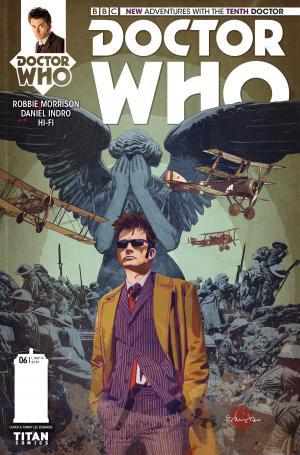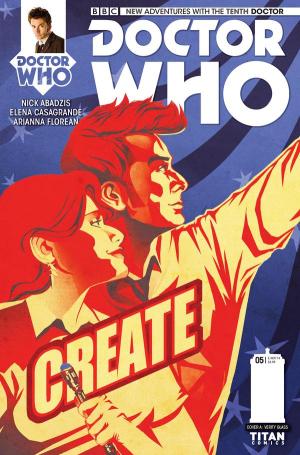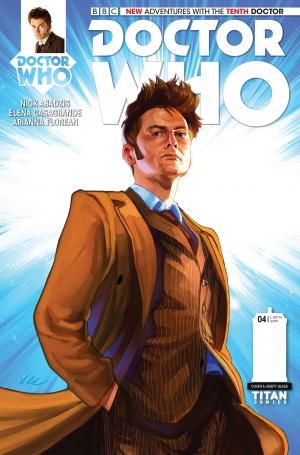Tenth Doctor #9 - The Weeping Angels of Mons (Part Four)
Writer: Robbie Morrison; Artist: Daniel Indro;
Letterer: Richard Starkings and Jimmy Betancourt;
Colorist: Slamet Mujiono; Editor: Andrew James;
Gabby's Sketchbook: Arianna Florean with Elena Casagrande;
Designer: Rob Farmer; Assistant Editor: Kirsten Murray
Perhaps moreso than is the case with any of the show’s other recurring antagonists, finding an inspired new way in which to off the titular menaces of “The Weeping Angels of Mons” must be one of the most unenviable tasks a Doctor Who scribe can encounter. That their creator Steven Moffat has already produced three largely acclaimed serials based around the Deadly Assassins’ antics can’t help matters either, particularly since 2007’s “Blink”, 2010’s “The Time of Angels / Flesh & Stone” and 2012’s “The Angels Take Manhattan” (not to mention Toby Whithouse’s “The God Complex” and Moffat’s “The Time of the Doctor”, wherein the Angels play second fiddle to a more substantial manner yet still make quite the impact in the space of but a few minutes of screen time) each use them to such great effect before resolving the threat they pose to the Tenth and Eleventh Doctors in an equally surprising manner.
No wonder, then, that in bringing the second full arc of Titan Comics’ New Adventures with the Tenth Doctor range to a timely conclusion after four instalments, Robbie Morrison can’t help but seem to struggle to wrap up proceedings without evoking the final moments of beloved episodes gone by. As if Tennant’s Doctor, Gabby Gonzalez and their newfound wartime comrade Jamie Colquhoun’s campaign beneath the trenches to rescue the TARDIS from the Angels’ clutches wasn’t enough of a call-back to their eternal foes’ on-screen history, as the final chapter of his “Mons” narrative grinds to a halt, Morrison moreover goes so far as to stir up memories aplenty of “Human Nature / The Family of Blood” (with the present day-set closing pages owing a particular debt to Paul Cornell’s haunting TV adaptation of his own New Adventures novel), “The Angels Take Manhattan” (via his second investigation into the Angels’ physical shortcomings in as many issues) and even Blackadder Goes Forth’s most poignant shot of all, though one could perhaps forgive the latter allusion in light of the plethora of Great War fiction available for us to experience nowadays. Indeed, add in an dishearteningly abrupt resolution to the romantic sub-plot brewing between Gabby and Jamie that simply reeks of necessity and readers might well start to wonder whether or not the “Mons” arc is as doomed as the waylaid soldiers who stumbled onto battlefields such as the Somme between 1914 and 1918.
As will surely have become clear by now, had this at times derivative mid-season finale (of sorts) persisted with this reliance upon its esteemed predecessors without injecting any original moments of note, then little doubt exists in this reviewer’s mind as to the extent that the “Mons” quartet as a whole would have been rendered as an unsatisfying tale, particularly in light of the number of instances where the words ‘déjà vu’ came to mind as the Angels made their initial appearances amongst the rubble and shadows of the trenches. The truth of the matter is mercifully different, though; thanks in no small part to Morrison’s sustained implementation of the creatures who give this arc its name as a metaphor for the conflict in which “Mons” takes place, the military chaplain who until now had served as little more than a cliché-spouting secondary player becomes of paramount significance at the very last moment, affording Part 4 no shortage of emotional resonance as he justifiably calls into question everything which the Christian faith has taught him in light of the angelic forces of (super)nature assaulting him and his companions from every corner. Better yet, whereas past televised Who serials such as “Tooth and Claw” have seen fit to simply have their antagonists slay these theistic devotees, here we’re presented with an entirely different send-off which leaves that much more of a lasting impression as a result (and one which we therefore shan’t spoil for fear of ruining the scene in question).
Whereas Morrison therefore tows the line between narrative familiarity and symbolic innovation, Arianna Florean, Elena Casagrande and Daniel Indro – the former two of whom open Part 4 with another of Gabby’s rather delightfully whimsical notebook sequences before the latter resumes his work as the series’ resident central artist – collectively give their all in terms of ensuring that from an aesthetic perspective, the Tenth Doctor’s escapades in the early 20th Century remain a joy to see play out from page to page. Even if Part 3’s “Blink”-riffing cliff-hanger didn’t so much shock as doubtless remind many readers of the aforementioned 2007 serial’s “the Angels have the police box” t-shirt, the shot made for one hell of a tour de force of Indro’s visual capabilities, a trait which carries through to this predictably action-packed fourth instalment, wherein the artist in question renders underground skirmishes, 19th Century villages and even stirring Great War memorial gatherings without missing so much as a single crucial opportunity to stimulate the reader’s optic nerves.
In fact, in spite of its occasional missteps into the realms of dependence upon what’s come before, that notion of aiming to keep its onlookers thoroughly engaged throughout its running time seems a fine summary of “The Weeping Angels of Mons”’ overall aspirations. Whether or not Morrison could have ditched some of the early moments of Angel mythology-recapping exposition and derivative set-pieces so as to condense Tennant’s sophomore Titan arc into three instalments as opposed to four is a matter which we could debate until the end of time itself (though this reviewer would personally wager that there’s a strong case to be made in that regard), but that Morrison and the team of apparently infinitely accomplished artists tasked with bringing his monthly narratives to life remained intent on leaving their audience with no option but to turn straight to the next page (or indeed head to the nearest relevant retailer in order to pre-order their copies of subsequent issues) in hindsight seems beyond dispute. It’s an admirable goal too, although as we move out of the blood-soaked battlefields of the early 1900s and back to the streets of New York for the final days of Gabby’s first year alongside a Time Lord who’s running on increasingly borrowed time, those involved with depicting this intriguing new companion’s scribbled writings and actions alike might well consider prioritising further layered moral dilemmas like that of the chaplain’s and in doing so placing less emphasis on the infrequently repetitive action set-pieces which formed the crux of “Mons”, at least if they’re hoping to leave Paul Cornell with a strong foundation upon which to build with his “Four Doctors” crossover event later this year.
Bonus Humour Strip Mini-Review:
Less surprising than Morrison’s success in turning his oft-predictable antagonists into a compelling metaphor for modern conflicts and the harrowing psychological toll they carry for those desperate to cling to their faiths is Rachael Smith’s decision to integrate the Sisters of Plentitude (of “New Earth” and “Gridlock” fame) into the latest gripping chapter of “A Rose By Any Other Name” as Rose – better known to regular readers as the Tenth Doctor’s hastily acquired feline pet – attempts to find her owner a date somewhere in the depths of time and space. Much like an elderly cat on its last legs, it’s difficult not to wonder whether this storyline (or series of narrative-light skits, to put the situation more accurately) has run its course at this point. On the plus side, though, even if that’s indeed the case, with only around half a dozen issues remaining until Cornell temporarily takes the helm of Tennant (as well as Smith, Capaldi and even Hurt)’s comic-book adventures, those who share this reviewer’s growing apathy with this particular line of mini-strips can at least rest safe in the knowledge that Rose’s short-lived tenure aboard the TARDIS will surely go the same way as K-9, Kamelion and Theta Sigma’s other non-human companions soon enough.










